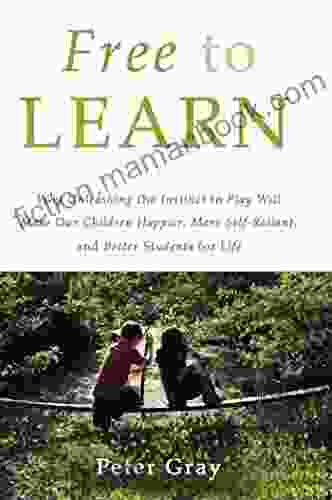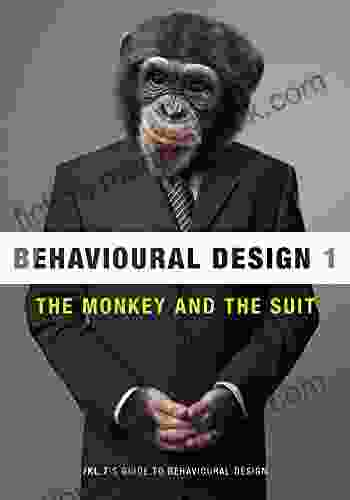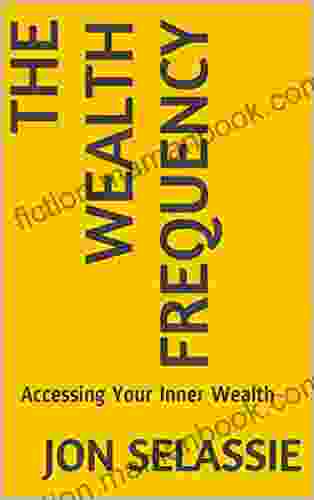The Monkey and the Suit: A Designer's Guide to Behavioural Design

In 2005, behavioural economist Dan Ariely conducted a fascinating experiment known as "The Monkey and the Suit." In this experiment, participants were given the option to choose between two suits: a cheap, unattractive suit or an expensive, attractive suit. Despite the fact that the expensive suit was objectively better, the majority of participants chose the cheap suit. Why? Because the cheap suit was more "monkey-like" - it resembled the suits that monkeys wear in cartoons and movies.
This experiment highlights the power of behavioural design. Behavioural design is the practice of using our understanding of human behaviour to create products, services, and environments that encourage people to make better choices. It's a powerful tool that can be used to improve our health, wealth, and happiness.
4.5 out of 5
| Language | : | English |
| File size | : | 1467 KB |
| Text-to-Speech | : | Enabled |
| Screen Reader | : | Supported |
| Enhanced typesetting | : | Enabled |
| Word Wise | : | Enabled |
| Print length | : | 15 pages |
| Lending | : | Enabled |
In this guide, we'll explore the principles of behavioural design and show you how to apply them in your own work. We'll cover topics such as:
* The psychology of decision-making * The role of emotions in behaviour * How to use nudges to encourage desired behaviour * How to create habit-forming products and services
By the end of this guide, you'll have a deep understanding of behavioural design and how to use it to create positive change in the world.
The Psychology of Decision-Making
To understand behavioural design, we need to first understand the psychology of decision-making. How do we make decisions? What factors influence our choices?
There are a number of factors that influence our decision-making, including:
* Our emotions * Our cognitive biases * Our social context * Our environment
Our emotions play a significant role in our decision-making. For example, we are more likely to make risky decisions when we are feeling happy or excited, and we are more likely to make conservative decisions when we are feeling sad or afraid.
Our cognitive biases also influence our decision-making. Cognitive biases are thinking errors that we all make from time to time. For example, we are more likely to overestimate the probability of events that are vivid and memorable, and we are more likely to underestimate the probability of events that are abstract and difficult to imagine.
Our social context also influences our decision-making. We are more likely to make decisions that are consistent with the norms of our social group. For example, if our friends are all driving expensive cars, we are more likely to want an expensive car ourselves.
Our environment also influences our decision-making. The layout of a store, the design of a website, and the placement of products can all influence our choices. For example, we are more likely to buy products that are placed at eye level than products that are placed on the bottom shelf.
The Role of Emotions in Behaviour
Emotions play a significant role in our behaviour. They can motivate us to take action, they can help us to make decisions, and they can shape our interactions with others.
There are a number of different emotions that can influence our behaviour, including:
* Happiness * Sadness * Anger * Fear * Surprise
Happiness is a positive emotion that can motivate us to take action and pursue our goals. Sadness is a negative emotion that can lead to withdrawal and isolation. Anger is a powerful emotion that can motivate us to fight or flight. Fear is a basic emotion that can protect us from danger. Surprise is an emotion that can trigger our curiosity and exploration.
Emotions can also influence our behaviour in more subtle ways. For example, we are more likely to be helpful and cooperative when we are feeling happy, and we are more likely to be aggressive and hostile when we are feeling angry.
How to Use Nudges to Encourage Desired Behaviour
Nudges are small changes to our environment that can encourage us to make better choices. Nudges can be used to improve our health, wealth, and happiness.
There are a number of different types of nudges, including:
* Defaults * Social norms * Reminders * Rewards
Defaults are choices that are presented to us as the default option. For example, when we sign up for a new credit card, the default interest rate is often set to a high rate. However, we can opt out of this default and choose a lower interest rate.
Social norms are the unwritten rules that govern our behaviour in society. For example, we are more likely to recycle if we see our neighbours recycling.
Reminders are simple messages that can help us to remember to do things. For example, we can set a reminder on our phone to take our medication or go for a walk.
Rewards are incentives that can motivate us to take action. For example, we may receive a discount on our health insurance if we get a flu shot.
Nudges can be a powerful tool for encouraging desired behaviour. They are relatively easy to implement and they can be very effective.
How to Create Habit-Forming Products and Services
Habit-forming products and services are those that we use regularly and automatically. They are often designed to be addictive, and they can be very difficult to break.
There are a number of different factors that can contribute to habit formation, including:
* Repetition * Reward * Cues
Repetition is the key to habit formation. The more we repeat a behaviour, the more likely it is to become automatic.
Reward is another important factor in habit formation. We are more likely to repeat behaviours that are rewarded.
Cues are external stimuli that trigger our habits. For example, the sight of a cigarette can trigger the urge to smoke.
We can use these factors to design habit-forming products and services. For example, we can create products that are rewarding, we can repeat them regularly, and we can use cues to trigger their use.
However, it is important to note that habit formation can also be used for negative purposes. For example, some companies design their products to be addictive and difficult to quit. This can lead to problems such as gambling addiction and social media addiction.
It is important to use habit formation techniques responsibly. We should only use them to create products and services that are beneficial to users.
Behavioural design is a powerful tool that can be used to improve our health, wealth, and happiness. By understanding the psychology of decision-making, the role of emotions in behaviour, and how to use nudges and habit formation techniques, we can create products, services, and environments that encourage people to make better choices.
Behavioural design is a relatively new field, but it has the potential to revolutionize the way we live. By using behavioural design principles, we can create a world where everyone has the opportunity to live a happy and fulfilling life.
4.5 out of 5
| Language | : | English |
| File size | : | 1467 KB |
| Text-to-Speech | : | Enabled |
| Screen Reader | : | Supported |
| Enhanced typesetting | : | Enabled |
| Word Wise | : | Enabled |
| Print length | : | 15 pages |
| Lending | : | Enabled |
Do you want to contribute by writing guest posts on this blog?
Please contact us and send us a resume of previous articles that you have written.
 Top Book
Top Book Novel
Novel Fiction
Fiction Nonfiction
Nonfiction Literature
Literature Paperback
Paperback Hardcover
Hardcover E-book
E-book Audiobook
Audiobook Bestseller
Bestseller Classic
Classic Mystery
Mystery Thriller
Thriller Romance
Romance Fantasy
Fantasy Science Fiction
Science Fiction Biography
Biography Memoir
Memoir Autobiography
Autobiography Poetry
Poetry Drama
Drama Historical Fiction
Historical Fiction Self-help
Self-help Young Adult
Young Adult Childrens Books
Childrens Books Graphic Novel
Graphic Novel Anthology
Anthology Series
Series Encyclopedia
Encyclopedia Reference
Reference Guidebook
Guidebook Textbook
Textbook Workbook
Workbook Journal
Journal Diary
Diary Manuscript
Manuscript Folio
Folio Pulp Fiction
Pulp Fiction Short Stories
Short Stories Fairy Tales
Fairy Tales Fables
Fables Mythology
Mythology Philosophy
Philosophy Religion
Religion Spirituality
Spirituality Essays
Essays Critique
Critique Commentary
Commentary Glossary
Glossary Bibliography
Bibliography Index
Index Table of Contents
Table of Contents Preface
Preface Introduction
Introduction Foreword
Foreword Afterword
Afterword Appendices
Appendices Annotations
Annotations Footnotes
Footnotes Epilogue
Epilogue Prologue
Prologue Caryl Churchill
Caryl Churchill Mrs Molesworth
Mrs Molesworth Marc Gregoire
Marc Gregoire Neerav Yadav
Neerav Yadav Jill Bialosky
Jill Bialosky Cheryl Douglas
Cheryl Douglas Jeffrey Poole
Jeffrey Poole S E Smith
S E Smith Gregory Waldron
Gregory Waldron Carlos R Mccray
Carlos R Mccray Claire Kart
Claire Kart Tessa Huff
Tessa Huff James Goldberg
James Goldberg Carrie Morey
Carrie Morey Rosie Weldon
Rosie Weldon Justin Payne
Justin Payne David Shapiro
David Shapiro S P Grogan
S P Grogan Mrs Serena
Mrs Serena Lisa Mills
Lisa Mills
Light bulbAdvertise smarter! Our strategic ad space ensures maximum exposure. Reserve your spot today!

 Mason PowellGladiator Love: The Enchanting Saga of Lance Morcan, the Warrior with a Heart...
Mason PowellGladiator Love: The Enchanting Saga of Lance Morcan, the Warrior with a Heart...
 Brennan BlairUnlocking the World of Music: A Comprehensive Guide to Basic Music Reading...
Brennan BlairUnlocking the World of Music: A Comprehensive Guide to Basic Music Reading... Paul ReedFollow ·17.8k
Paul ReedFollow ·17.8k Dominic SimmonsFollow ·2.6k
Dominic SimmonsFollow ·2.6k Blake BellFollow ·15.3k
Blake BellFollow ·15.3k Chris ColemanFollow ·19.6k
Chris ColemanFollow ·19.6k Jacob HayesFollow ·12.5k
Jacob HayesFollow ·12.5k Mason PowellFollow ·14.1k
Mason PowellFollow ·14.1k Stephen FosterFollow ·10.6k
Stephen FosterFollow ·10.6k Glen PowellFollow ·7.7k
Glen PowellFollow ·7.7k

 Abe Mitchell
Abe MitchellWhy Unleashing the Instinct to Play Will Make Our...
Play is an essential part of childhood. It is...

 Rubén Darío
Rubén DaríoTheory in Health Promotion Research and Practice
Theory is essential...

 Howard Blair
Howard BlairFailing Students or Failing Schools: Uncovering the Root...
In the United States, the issue of failing...

 Ira Cox
Ira CoxPoetry From the Heart Chope: A Symphony of Soul and Verse
Embark on a literary...

 Easton Powell
Easton PowellThe Witch Hunt: Wicked Witches of Shadow Woods
In the cursed woods of...
4.5 out of 5
| Language | : | English |
| File size | : | 1467 KB |
| Text-to-Speech | : | Enabled |
| Screen Reader | : | Supported |
| Enhanced typesetting | : | Enabled |
| Word Wise | : | Enabled |
| Print length | : | 15 pages |
| Lending | : | Enabled |










